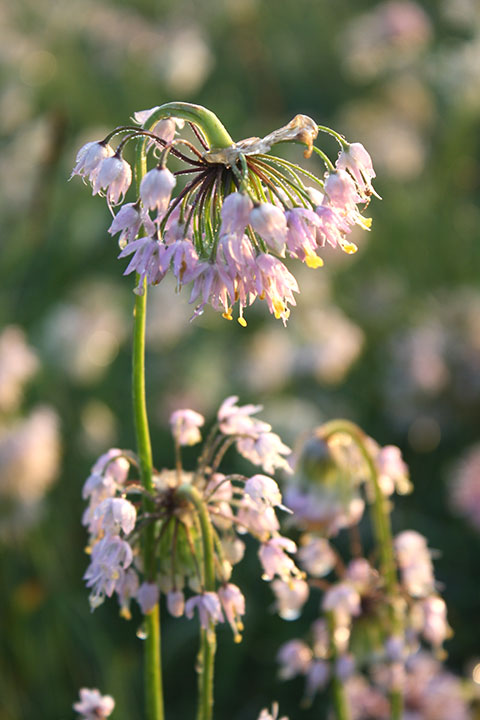FAQs
Is it a weed? Or is it a plant? Should I leave it, or should I pull it? The questions about native plantings are as numerous as the plants themselves. Whether you have a private garden or manage acres of prairie, find the answers to your native planting questions here.
So you want to start a native planting!
Where do I begin?
First things first, you need to get rid of weeds and any turfgrass. There are a variety of options, on smaller-scale projects a heavy mulch or solarizing with a layer of black plastic may be practical. On large-scale projects, herbicide application may be the most practical and effective method. When feasible, we prefer non-chemical treatments.
Should I have the soil tested before I start planting?
Not typically, though it is a good idea to assess the relative amounts of sand or clay present.
Is soil fertilization necessary before establishing a native planting or restoration?
No. The use of fertilizers is definitely NOT recommended. Prairies thrive in low-nitrogen environments, while weeds thrive in high-nitrogen environments. When you fertilize, you’re feeding weeds.

How many different plant species do I need to plant?
True native prairies are composed of hundreds of species. A baseline mix for a new planting should contain at least two to four grasses and six to 12 forbs. However, the sky is the limit! In fact, high species diversity is usually better. We recommend at least 30 species per planting if your budget and site conditions allow.
Should I use seeds, seedlings or a combination of both?
The answer depends on a couple of things – money and time. Starting from seed takes a minimum of three years but is more cost-effective. Starting with plants will give you immediate results, but is costly, especially for large areas. Starting with a combination of seeding large areas and using plants in specific accent areas is a good compromise, giving you beautiful results right away while you wait for other areas to become established.
Let’s dig a little deeper
Do established plantings need to be watered during dry spells?
No. Extra water is needed only during establishment when drought occurs.
Can I plant natives on my septic mound?
Yes. You will want to choose hardy species that withstand a variety of conditions. Also, stay away from species with a large taproot (no legumes. Asclepias or Silphium species). We offer a seed mix specifically for septic mound planting.
How often should I do a prescribed burn?
For prairie, savanna, wetland, and meadow planting, we recommend burning every two to four years on a spring and fall rotational burning schedule. Yearly burning is not necessary and will decrease species diversity and negatively impact beneficial insect populations. Incomplete burns protect wildlife habitat by leaving patches of cover. Woodland areas can also benefit from occasional burning for invasive species. Be aware that some woodland species may be adversely effected. So when burning woodland areas, only burn a small section each time.
What percentage of plants in my planting should be grasses? Forbs?
Every site is different, however, as a general rule, it’s 50 percent forbs and 50 percent grasses. To achieve this composition, a seed mix of approximately eight lbs. of grass seed to every two to three pounds of forb seed is used. This ratio varies based on seed size and species selection.
What is a forb?
A forb is a flowering plant with a non-woody stem that is not a grass.
If I want a wildflower field, do I need to plant grasses too?
Yes, and here’s why:
- Native grasses and sedges fill a niche that – if left vacant – will be filled by weeds.
- Grasses and sedges literally support flowers, holding them up so they will not lodge (flop over).
- Grasses and sedges are important hosts for butterflies and provide nesting material, shelter, and a food source (seeds and attracted insects) for songbirds.
- In nature, you would never see a field of just wildflowers. Other plants are needed for the field to function as a system. That’s why it’s called an ecosystem.
How late in the fall can I plant live plants?
Technically, you can plant until the ground is frozen. However, it’s recommended to plant no later than September 15 in the Midwest. In other areas, calculate two weeks before the first anticipated week of hard freeze.
Planting by September 15 will give your plants a better shot for their roots to establish enough to withstand the winter. While you can plant after September 15, you’ll need to take extra care by applying a 3” minimum of mulch (taking care not to smother the plant row to allow for light and rejuvenation in the spring) and frequently checking for frost heaving. Frost heaving happens when the ground freezes and thaws, causing the plug to come out of the ground and exposing the plant’s roots to cold and dry conditions. If this occurs, tamp the plant back into the ground.
Cost-wise, which is better – a native prairie or a bluegrass lawn?
The up-front costs of establishing a native prairie are very similar to those of a typical lawn grass seeding. While prairie plantings take longer to establish than grass, they require less ongoing maintenance, no regular mowing, and no fertilizer or pesticides. Over the long run, a native prairie is more cost-effective than a bluegrass lawn because you will not have the costs associated with maintenance, chemicals, fertilizer, water systems, lawn equipment, fuel – and your time. An added bonus – some communities offer a tax break for native plantings on your property.
Can I mix natives with non-natives?
Yes. Combining natives and non-natives into your landscaping is a good way to visually tie your native plantings into neighboring landscapes.
Does the pollen from native plants such as goldenrod (Solidago) cause allergies?
While some people are allergic to members of the Aster family, including goldenrods, you would have to have close contact for an allergic reaction. Goldenrods and most other native wildflowers are insect-pollinated rather than wind-pollinated. Pollens of most insect-pollinated species are too large and heavy to become airborne and then inhaled. Airborne pollens, produced by trees, grasses, and ragweed are the cause of most seasonal allergies.
Why should I choose native plants instead of non-native plants?
There are so many reasons to choose planting natives. For one thing, you can feel good about planting natives because it opens a space to species from some of our most endangered habitats. Plus:
- Natives require less watering and chemicals.
- Natives are hardier to extreme local weather conditions.
- Natives tend to have greater disease resistance.
- Natives are a preferred source of food and cover for birds, butterflies, and other desirable wildlife.
- Native plantings can help ease flooding in your area. Natives have deep roots and varied root systems that enable good stormwater infiltration, which also replenishes the groundwater), help mitigate flooding and reduce loads on storm sewers.
Help! The deer are eating my native plants.
Deer LOVE legumes and are attracted to tall grasses. Avoid those and you have a good start at keeping the deer from using your prairie as a buffet.
Help! I want to see more deer in my prairie.
Deer seek the cover that tall grasses provide and they prefer to browse on blossoms in early spring and legumes throughout the spring. Indian grass (Sorghastrum nutans), Purple prairie clover (Dalea purpea), Canada tick trefoil (Desmodium canadense), Round-headed bush clover (Lespedeza capitata), and Illinois tick trefoil (Desmodium illinoense) are all plants that attract and support deer.
Let’s talk about Weeds
Is it harmful to have some weeds?
No. As long as weeds are kept to a manageable level, they will not present a problem. In fact, some weeds are beautiful when they flower.
Will there ever be a time when all the weeds are gone?
No. Even minor soil disturbances such as ant mounds and wild animal tracks provide sufficient habitat for some weeds to establish.
Are all weedy species annuals?
No. Some weedy species, such as bluegrass are perennials. These species are not as easily removed or replaced through succession, competition, mowing, or fire. While they might not be eliminated for a number of years, good practices can reduce them to minor components within the prairie landscape.
How do I place a order?
Availability changes very quickly. In the event the product you have requested has become unavailable or is not available from your regional growing location we will reach out.
We have a minimum 10 tray order for plants and $500 order for seed.
Orders by noon on Wednesday are shipped the following week, generally.
